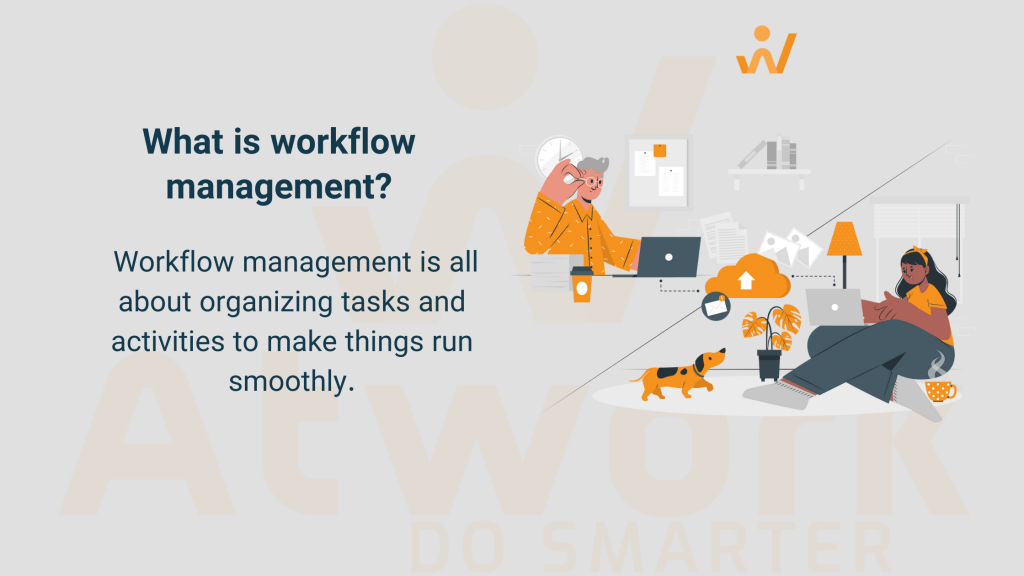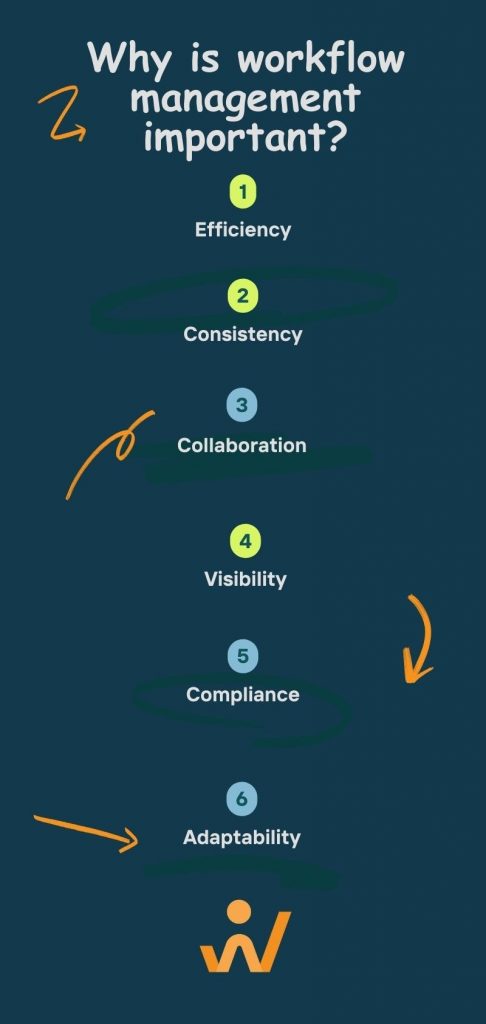What is workflow management?

Welcome to Atwork latest blog post exploring the world of workflow management! In this article, we’ll delve into the intricacies of what workflow management entails, the essential skills needed, and how a workflow management app can revolutionize your productivity. Let’s dive in!
What is workflow management?
What is workflow management? It’s all about organizing tasks and activities to work smoothly. Whether you’re using free tools like open-source workflow management, specific ones like Fortigate, or popular ones like Microsoft, it’s about making things run efficiently. Workflow management is all about organizing tasks and activities to make things run smoothly. Atwork workflow management involves using free tools to streamline workflows without added costs. Ultimately, the goal of workflow management is to improve efficiency and collaboration within an organization.

The different types of workflows
There are several types of workflows commonly used in various industries and business processes. Here are some of the most common types: Sequential Workflow: This is a linear workflow where tasks are completed one after the other, following a specific order or sequence.
Sequential Workflow: This is a linear workflow where tasks are completed one after the other, following a specific order or sequence.
Parallel Workflow: In this type of workflow, multiple tasks or processes are carried out simultaneously, without being dependent on each other.
Rule-based Workflow: Rule-based workflows use predefined rules or conditions to determine the flow of tasks or processes. Actions are triggered based on these rules.
Dynamic Workflow: Dynamic workflows are flexible and adaptable, with tasks or processes being determined dynamically based on real-time data or user inputs.
Document Workflow: Document workflows involve the creation, review, approval, and distribution of documents within an organization. These workflows help streamline document-related processes.
Human-centric Workflow: Human-centric workflows focus on tasks that require human intervention or decision-making. These workflows often involve collaboration and communication among team members.
System-centric Workflow: System-centric workflows are automated processes that are driven by software systems or applications, with minimal human intervention.
These are just a few examples of the different types of workflows, and many workflows may combine elements of multiple types depending on the specific requirements of the process.
The basic components of a workflow
The basic components of a workflow typically include:

Tasks: These are the individual actions or activities that need to be completed as part of the workflow. Tasks can be assigned to specific individuals or groups.Sequence: The sequence refers to the order in which tasks are performed within the workflow. Some workflows have a predefined sequence, while others may allow for tasks to be completed in parallel or in a flexible order.
Conditions: Conditions are criteria or rules that determine when certain actions or tasks should be executed within the workflow. These conditions may be based on factors such as time, data inputs, or user interactions.
Participants: Participants are the individuals or roles involved in carrying out the tasks within the workflow. Each participant may have specific responsibilities and permissions within the workflow.
Notifications: Notifications are alerts or messages that inform participants about new tasks, updates, or changes within the workflow. These notifications help keep participants informed and ensure timely action.
Approvals: Approval processes are often a key component of workflows, especially for tasks that require review or authorization before they can be completed. Approvals may involve one or more individuals or stakeholders.
Data: Data is information that is input, processed, or generated as part of the workflow. Data may be used to trigger actions, make decisions, or provide input for tasks.
Feedback and Monitoring: Feedback mechanisms allow participants to provide input, comments, or feedback on tasks or the overall workflow. Monitoring tools track the progress of tasks and provide insights into workflow performance.
These components may vary depending on the complexity and nature of the workflow, but they form the foundation of most workflow processes.
What is a workflow management system?
A workflow management system (WMS) is a powerful tool for organizations to streamline their processes and improve efficiency. Whether you’re looking for a free solution or exploring paid options, there are plenty of workflow management tools available to suit your needs.
Some popular examples of workflow management apps include Atwork, Trello, Asana, and Monday.com. These platforms offer intuitive interfaces and robust features to help you design, automate, and track your workflows effectively.
For instance, imagine you’re running a marketing campaign with multiple tasks and deadlines. A workflow management app like Trello allows you to create boards, lists, and cards to organize your tasks. You can assign tasks to team members, set due dates, and track progress in real-time.

Another example is Asana, which offers customizable project templates and automation features to streamline your workflow. With Asana, you can create task dependencies, set up recurring tasks, and integrate with other tools to automate repetitive processes.
Whether you’re managing a small team or a large enterprise, workflow management tools provide the flexibility and scalability you need to stay organized and productive.
Why is workflow management important?
Workflow management is important for making work easier and more organized. Here’s why:
Efficiency: Workflow management helps things get done faster and with fewer mistakes. It saves time by automating tasks and making sure everyone knows what they’re supposed to do.
Consistency: It helps keep things the same way every time, which is good for quality and keeping customers happy.
Collaboration: Workflow management lets people work together easily. It helps teams share information and work together on projects.
Visibility: It lets everyone see what’s going on with a project, so they know if things are going well or if there are problems that need fixing.
Compliance: It helps make sure that work is done the right way, following rules and standards.
Adaptability: Workflow management tools can change to fit the needs of a business as they grow and change.
There are lots of workflow management tools out there, from free ones to paid ones. Examples include Atwork.
Atwork is a workflow management tool designed to help businesses streamline their processes and improve productivity. It offers a range of features to facilitate task management, collaboration, and automation.
Atwork workflow management capabilities
Task Management: Atwork provides a centralized platform for organizing tasks, assigning them to team members, and tracking their progress. Users can create tasks, set due dates, and prioritize them based on urgency.
Collaboration: With Atwork, teams can collaborate seamlessly on projects. Users can share files, exchange messages, and provide feedback within the platform, fostering communication and teamwork.
Automation: Atwork offers automation features to simplify repetitive tasks and streamline workflows. Users can create automated workflows that trigger actions based on predefined conditions, such as task completion or deadline reminders.
Customization: Atwork allows users to customize their workflows to suit their specific needs. They can create custom task templates, define workflow stages, and configure automation rules to match their business processes.
Integration: Atwork integrates with other popular business tools and platforms, allowing users to sync data across different applications. Integration with tools like Google Workspace, Microsoft 365, and Slack enables seamless collaboration and data sharing.
Reporting and Analytics: Atwork provides reporting and analytics features to track workflow performance and identify areas for improvement. Users can generate reports on task completion rates, project timelines, and team productivity to gain insights into their workflow efficiency.
Overall, Atwork offers a user-friendly and feature-rich solution for managing workflows and improving team collaboration. Whether you’re a small business or a large enterprise, Atwork can help streamline your processes and boost productivity.
